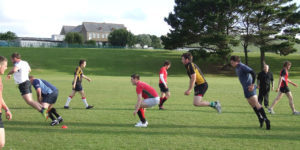Strength is crucial for successful rugby. Tackling, scrummaging, sprinting, rucking, and mauling are all strength-specific activities. Strength is also important for injury prevention as increased strength usually means increased joint and core stability.
However, like the sport of rugby itself, training for strength can be hard on your joints. To develop strength, most ruggers utilize the traditional approach of compound barbell exercises and heavy weights. While effective, if you are already feeling beaten up from rugby, adding heavy strength training into the mix can make painful joints worse.
This creates a seemingly impossible conundrum; you need to be strong for rugby, but traditional strength training is killing your already sore joints. What’s a rugger to do?
5 rules for successful joint-friendly strength training
If you have joint pain, or just want to avoid it in the future, follow these rules when designing your workouts.
#1 – use the two C’s
Comfort – any exercises you do should feel comfortable and natural.
Control – make sure you can perform your chosen exercises with good technique. If you can’t, reduce the load, or seek out a simpler alternative. Bad exercise technique can lead to injury and joint pain.
#2 – Modify
To be comfortable and in control, you may need to modify your chosen exercises. Move your hands or feet, change the angle of the bench, or reduce the range of motion to avoid pain. With a little experimentation, you may be able to find a position that is easier on your joints.
#3 – If it hurts, don’t do it!
If an exercise hurts you, even if you modify it, don’t do it. In certain cases, this may mean you have to give up certain exercises. If you look hard enough, you should be able to find a more joint-friendly alternative.
#4 – Introduce new exercises gradually
So, you’ve found a new way to exercise that doesn’t cause you pain. Good job! Make sure you introduce it gradually to monitor how it feels and how it affects your joints. Doing too much too soon could exacerbate joint pain.
#5 – Look for ways to get more from less
Less weight, fewer reps, fewer sets, shorter workouts, and fewer workouts can all help reduce joint pain. Look for ways to get more benefit from less training to reduce the stresses that are responsible for joint pain.
Joint-friendly training options for beat-up ruggers
Here are some useful and effective ways to train for strength without hammering your joints. If you have joint pain, these training methods should help you to maintain or even increase your strength, without making existing joint pain worse.
Of course, if you have an injury that requires medical treatment, make sure you seek professional advice as even these joint-friendly methods could make some types of joint pain worse.
1) Use a sled
For lower body strength training, sled training is hard to beat. Normally thought of as conditioning tool, you can also use a sled for building strength, size and power in your lower and upper body.
If you drag a heavily loaded sled backward, you provide your quads with a very knee-friendly workout that is a good alternative to squats. In contrast, dragging a sled forward is an effective alternative to deadlifts, but without the stress on your lower back. Use hand-held straps instead of a hip belt to provide your upper body with a workout at the same time.
Check this video for some heavy sled pulling action:
2) Adopt a slower tempo
The stronger you are, the more weight you can lift, and the more stress you place on your joints. However, your muscles don’t really know weight, they only know work and tension.
Slower lifting tempos eliminate momentum, keeping the stress on the target muscles throughout the entire range of movement. This makes any exercise you perform considerably harder, forcing you to use less weight.
Make a conscious effort to lift and lower your weights more slowly to take stress off your joints. A 2:2 or 3:3 tempo is ideal – it’s slow enough that you’ll have to use less weight than normal, but not so slow that strength gains will be compromised, as can happen with slower tempos.
3) Aqua plyometrics
Plyometrics are jumping exercises designed to develop speed strength, better known as power. Plyometrics are undeniably effective, but can really hammer your joints. Repetitive heavy landings will shock-load your feet, ankles, knees, hips, and spine – even more so if you are a big front row forward!
Aqua plyometrics are very similar to regular plyometrics except they are done in deep water. This significantly reduces that potentially injurious landing force. With a little imagination, almost any plyometric exercise can be performed in water to make it more joint friendly – and that includes medicine ball throwing exercises as well as traditional jumping exercises.
Check out this video to learn more about aqua plyometrics:
4) Single limb training
In general, you cannot lift as much weight with one limb as you can with two. For example, you might be able to squat 100kg for ten reps, but may not be able to do even one single leg squat.
Switching to single leg exercises means more productive training with less weight and, therefore, less joint stress. Single limb training also enhances core stability, joint stability, and is potentially more rugby-specific. You can read more about unilateral or single limb training in this article or in our leg workout program.
5) Swing, don’t clean or snatch
Lots of ruggers train using the Olympic lifts and their variations. And why not? They are great for developing the explosive power needed for successful rugby. However, like plyometrics, the Olympic lifts can be hard on your joints, and that includes the simplified power versions too.
The main thing that links all the Olympic lifts is hip extension. The trajectory of the barbell is almost secondary; it’s simply the natural result of jumping with a weight in your hands. With that in mind, for a more joint-friendly exercise that is also great for developing explosive hip extension, give heavy kettlebell swings a try.
Swings are initiated with a snappy hip extension, but the weight follows a more joint-friendly trajectory. Also, you don’t need to catch the weight on your already sore shoulders, or overhead in a position that is seemingly designed to hurt your joints.
If you don’t have access to really heavy kettlebells, you can use a loadable T-shaped handle called a Hungarian core blaster, or add a resistance band to make your light kettlebell feel like it weighs much more.
See how to combine a resistance band with kettlebell for swings here:
6) Limit your range of motion
Exercises that involve a long range of motion are often linked to increased joint pain i.e. ass-to-grass squats, deadlifts from the floor, and bench presses where the bar touches your chest. Such long ranges of motion can lead to compromised, painful joints. However, these exercises are also amongst the best for developing strength.
Enjoy the benefits of these exercises with fewer aches and pains by purposely limiting the range of motion. In each instance, the inner range of motion is reduced, leaving the outer range intact, so that you can still use heavy weights and develop useable strength.
Good options include:
- Box squats
- Rack deadlifts
- Deadlifts off blocks
- Romanian deadlifts
- Bench press to pins
- Floor presses
- Overhead presses from pins
7) Use resistance bands
When it comes to building strength, most ruggers tend to think of barbells, dumbbells, and other traditional training methods. The thing is, lifting weights can be hell on sore joints. Getting a heavy, stationary weight moving places a lot of strain on your joints, and the lock position is often hard on your joints too.
Instead of pumping iron, give your joints a break by pumping rubber instead. Resistance band exercises are much more joint friendly as there is no moment of inertia to overcome at the start of each rep.
You don’t have to give up weights altogether, and can combine bands with barbells to create a joint-friendly workout that will still develop formidable strength. Using bands and barbells together takes stress off the joint-compromising inner range of motion, while adding resistance as you approach the safer, more comfortable outer range.
With a little imagination, you should be able to use bands with almost any barbell exercise. Just reduce the weight on the bar, add a band or two, and make your chosen exercises much more joint-friendly.
SUMMARY
While you need to train hard for rugby, you need to train smart too. Rugby is hard enough without rubbing salt into your wounds in the gym too! Use these methods to make your workouts easier on your joints, and you could extend your playing career by several years. Make sure you are also consuming adequate adequate protein, essential for good joint health, by making Rugby Whey part of your supplement regimen.


